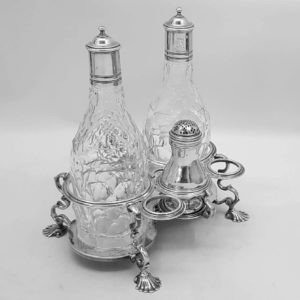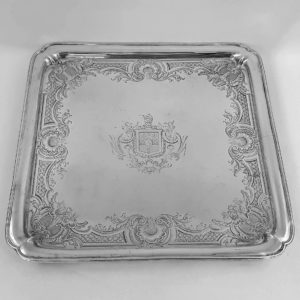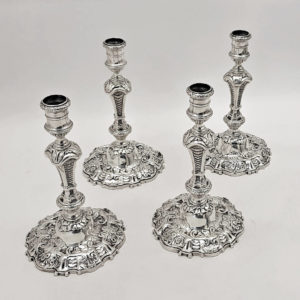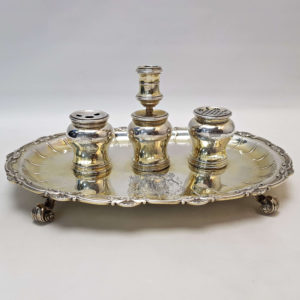Elizabeth Godfrey
Eliza (c.1700-1771) didn’t have a formal apprenticeship, instead she must have learnt her trade as a child in the family’s London workshop belonging to her father Simon Pantin (1666-1733). Pantin was a leading Huguenot goldsmith with a prestigious clientele and examples of his fine work can be seen in major museums and collections worldwide.
Eliza’s marriage in 1721 to London goldsmith Abraham Buteaux (1698-1731) will have allowed her to continue her craft skills. Abraham was her father’s Huguenot nephew and godson, and was apprenticed to him in 1711, free in 1718. In 1721 Abraham entered 2 marks (Sterling and New Standard) and the married couple set up business in Green St, moving to Norris St in 1731. Just a few short months later Abraham died and Eliza, 3 months pregnant at the time, continued the business and entered her own widow’s mark as Elizabeth Buteux. The Buteux’s work bears similarity to that of Simon Pantin – mainly plain cups, other hollow-ware and salvers.
The following year in 1732 Eliza, 7 months pregnant with Abraham’s child, married Benjamin Godfrey (1699-1741), a London jeweller with a neighbouring shop in Norris Street. Benjamin, born to an affluent English family, continued both the jeweller’s shop and the silversmith’s premises in Norris St. Despite having no experience of silvermaking he entered marks at Goldsmiths Hall as largeworker, presumably for use by Eliza. 1st mark in 1732, 2nd and 3rd marks in 1739. The Godfreys’ work displays strong Huguenot influences in design and fine execution, their later works incorporating rococo designs. Just as one would expect from a family background such as Eliza’s.
When Benjamin died in 1741 Eliza entered her second widow’s mark as Elizabeth Godfrey. She remained active until at least 1766 and her work was known for its high quality and sophisticated style. Her trade card described herself as “Goldsmith, Silversmith and Jeweller to the Duke of Cumberland” and her success is evident by the considerable quality and quantity of her surviving work.
Eliza had 10 children of whom 5 reached adulthood. Of these, only Panton Betew (1723-1799) worked in the industry as a silver and art dealer
A significant number of strong and powerful female silversmiths achieved successful careers during the 18th century, a time when women enjoyed very few rights, especially in a male dominated industry. The Goldsmith’s Company records 63 women silversmiths working between 1697 and the Victorian era.
biography extracted from Sandra Robinson’s “Simon Pantin & His Children”
Elizabeth Godfrey
Eliza (c.1700-1771) didn’t have a formal apprenticeship, instead she must have learnt her trade as a child in the family’s London workshop belonging to her father Simon Pantin (1666-1733). Pantin was a leading Huguenot goldsmith with a prestigious clientele and examples of his fine work can be seen in major museums and collections worldwide.
Eliza’s marriage in 1721 to London goldsmith Abraham Buteaux (1698-1731) will have allowed her to continue her craft skills. Abraham was her father’s Huguenot nephew and godson, and was apprenticed to him in 1711, free in 1718. In 1721 Abraham entered 2 marks (Sterling and New Standard) and the married couple set up business in Green St, moving to Norris St in 1731. Just a few short months later Abraham died and Eliza, 3 months pregnant at the time, continued the business and entered her own widow’s mark as Elizabeth Buteux. The Buteux’s work bears similarity to that of Simon Pantin – mainly plain cups, other hollow-ware and salvers.
The following year in 1732 Eliza, 7 months pregnant with Abraham’s child, married Benjamin Godfrey (1699-1741), a London jeweller with a neighbouring shop in Norris Street. Benjamin, born to an affluent English family, continued both the jeweller’s shop and the silversmith’s premises in Norris St. Despite having no experience of silvermaking he entered marks at Goldsmiths Hall as largeworker, presumably for use by Eliza. 1st mark in 1732, 2nd and 3rd marks in 1739. The Godfreys’ work displays strong Huguenot influences in design and fine execution, their later works incorporating rococo designs. Just as one would expect from a family background such as Eliza’s.
When Benjamin died in 1741 Eliza entered her second widow’s mark as Elizabeth Godfrey. She remained active until at least 1766 and her work was known for its high quality and sophisticated style. Her trade card described herself as “Goldsmith, Silversmith and Jeweller to the Duke of Cumberland” and her success is evident by the considerable quality and quantity of her surviving work.
Eliza had 10 children of whom 5 reached adulthood. Of these, only Panton Betew (1723-1799) worked in the industry as a silver and art dealer
A significant number of strong and powerful female silversmiths achieved successful careers during the 18th century, a time when women enjoyed very few rights, especially in a male dominated industry. The Goldsmith’s Company records 63 women silversmiths working between 1697 and the Victorian era.
biography extracted from Sandra Robinson’s “Simon Pantin & His Children”
-


1751
Elizabeth Godfrey
9913 George II Silver Cruet Set
£3,950
A rare early English silver cruet with two bottles for oil and vinegar and a small silver castor or pepperette. Excellent weight and large size. The heavy cut crystal bottles have multi-faceted cut decoration, typical of the period. The silver frame has an acanthus scroll carrying handle and side supports for the bottle tops and pepperette. The top of the frame has a hand engraved armorial which matches those on the bottle tops. Total weight of silver 955 grams, 30.7 troy ounces. Height 23.5cm (overall), 20.7cm (bottle), 9.5cm (pepper). Base measures 19.3 x 16.3cm. London 1751. Maker Elizabeth Godfrey, a highly respected Huguenot lady silversmith.
-


1758
Elizabeth Godfrey
9843 George II Silver Salver
Sold
Excellent large size. A fine early English salver with the square form and plain styling typical of the period. The hand engraved border has a detailed band of scrolls, shells and matting with mythical face masks to the corners and erupting volcanoes to the sides. To the centre is a family coat of arms within a decorative cartouche. Weight 2194 grams, 70.5 troy ounces. Height 3 cm. Diameter 40 cm. London 1758. Maker Elizabeth Godfrey, whose Huguenot origins can be seen in this piece.
-


1741
Elizabeth Godfrey
9910 Set of 4 George II Antique Silver Candlesticks
Sold
An exceptional set of antique silver candlesticks in the French Huguenot taste. Fine quality and made of heavy gauge cast silver. The early rococo style bases are decorated with seashells, flowers and scrolls. Total weight 2,444 grams, 78.5 troy ounces. Height 20.3cm. Diameter of base 12.3cm. London 1741. Maker Elizabeth Godfrey.
-


1741
Elizabeth Godfrey
10209 George II Antique Silver Inkstand
Sold
An exceptional early English silver inkstand of oval form with a cast shell border and raised on four cast scroll feet. Gilt finish. Good gauge silver and heavy weight. To the top are two cylindrical containers for ink and sand and a detachable candlestick mounted on a circular box. Hand engraved to the top with a coat of arms and motto “Pax in Bello” for the Osborne family; the two pots and taperstick all with a matching crest. Weight 1485 grams, 47.7 troy ounces. Height 13.25cm. Length 34.4cm. Width 22.5cm. London 1741. Maker Eliza Godfrey. Sterling silver.